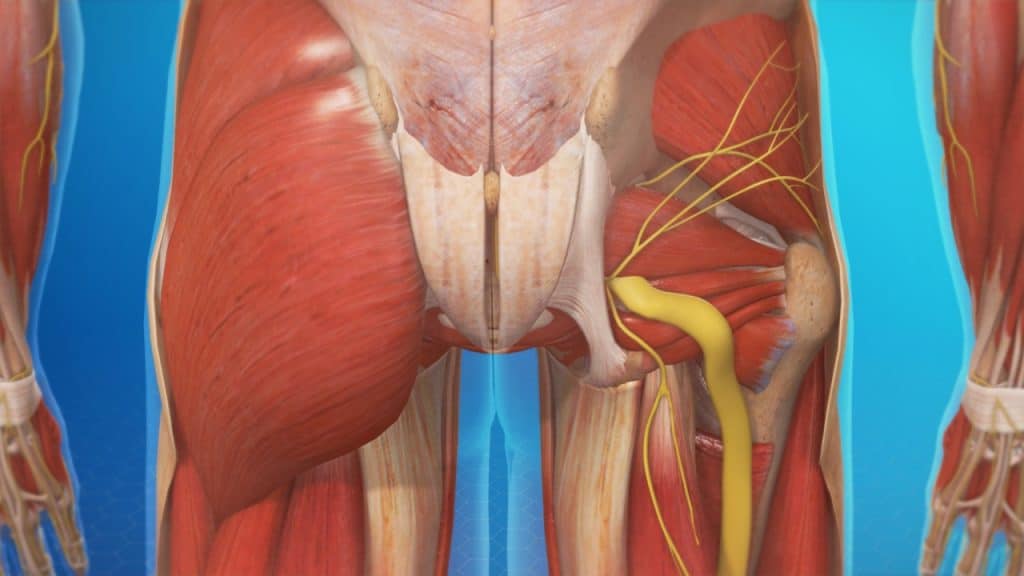Overview
Piriformis syndrome is a disease that is caused when the piriformis muscle, located in the buttock, spasms and causes buttock pain. The piriformis muscle can also compress or irritate the nearby sciatic nerve causing pain, numbness and tingling in the buttock and along the back of the leg and into the foot, similarly to sciatic pain.
Anatomy (Piriformis Muscle)
The piriformis muscle is a flat, band-like muscle located deep in the buttocks. It originates at the internal surface of the sacrum (triangular bone at the bottom of the spine) and inserts at the superior (upper) border of the trochanter of the femur (thighbone). This muscle has a very important role in lower body movement because it stabilizes the hip joint and assists in rotating the hip and turning the leg and foot outward.
Anatomy (Sciatic Nerve)
The sciatic nerve is the largest nerve in the human body. It is formed by the union of 5 nerve roots from the lower spine. It passes deep into the buttock, alongside it, or goes through the piriformis muscle, and down the back of the thigh all the way to the heel and sole of the foot. The sciatic nerve plays a vital role in connecting the spinal cord with the skin and muscles of the thigh, leg and foot.
Causes
The exact causes of piriformis syndrome are unknown. In many cases, there is a history of trauma to the buttock region, repetitive, vigorous activity such as long-distance running, bicycling or prolonged sitting. When the piriformis muscle shortens or spasms due to trauma or overuse, it can compress or strangle the sciatic nerve beneath the muscle. Piriformis syndrome may also result from anatomical variations in the muscle-nerve relationship. Irritation or dysfunction of a nearby structure such as the sacroiliac joint as well as inactive gluteal muscles may also facilitate development of the syndrome.
Symptoms
Most commonly, patients describe acute tenderness in the buttock and sciatica-like pain, numbness and tingling down the back of the thigh, calf and foot. The symptoms often become worse after prolonged sitting, walking upstairs or running, and may feel better after lying down on the back. Often, it may be hard for the patient to sit comfortably.
Treatment
Treatment usually begins with stretching exercises to help reduce sciatic nerve compression. The avoidance of contributary activities such as running, bicycling and prolonged sitting is important to relieve symptoms.
Treatment options for piriformis syndrome may include rest, ice packs and ice massage, heat therapy, analgesic/anti-inflammatory medications, muscle relaxants, manual and physical therapy. The application of electrical stimulation to the buttock with a transcutaneous electrical nerve stimulation (TENS) can help to block pain and reduce muscle spasm related to piriformis syndrome.
Moreover, a local anesthetic and corticosteroid may be administered directly into the piriformis muscle not only to diagnose piriformis syndrome but also to achieve reduction of the spasm and pain.
If a painful, tense piriformis muscle is resistant to treatment with anesthetic/corticosteroid injections, an injection of botulinum toxin (Botox), a muscle weakening agent, may be useful.
In unusually chronic, severe and persistent cases, the piriformis muscle can be cut to relieve symptoms.
References
- Peterson L., Renström P.: Verletzungen im Sport. Prävention und Behandlung. 3. Auflage. Deutscher Ärzte-Verlag 2002.
- Gautschi R.: Manuelle Triggerpunkt-Therapie. Myofasziale Schmerzen und Funktionsstörungen erkennen, verstehen und behandeln. Thieme 2010.
- Fischer J.: Schmerztherapie mit Lokalanästhetika. Injektionstechniken – einfach und sicher. 1. Auflage. Thieme 2000.



